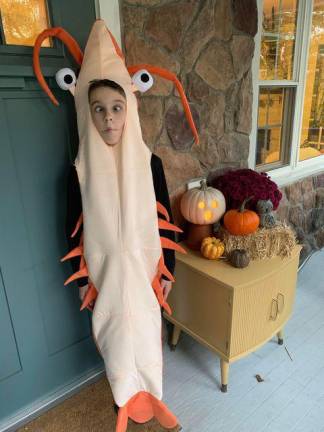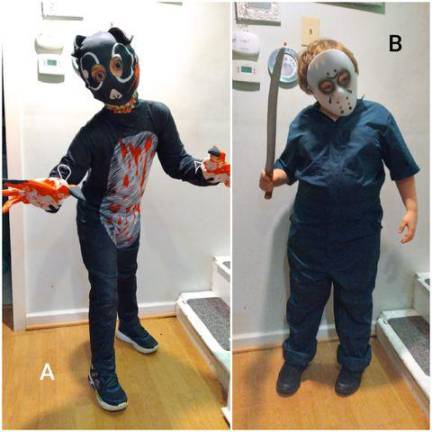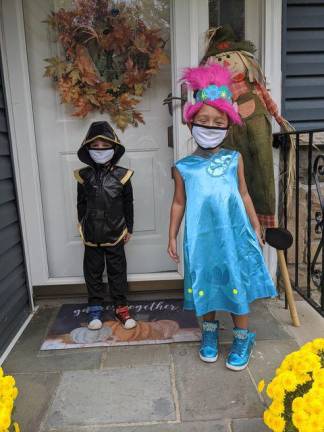Halloween isn’t canceled
Holiday. But it’s definitely going to look a little different this year, with fewer trick-or-treaters, more candy left outside to grab-and-go, and lots of (non-Halloween) masks.



“Have a safe Halloween” has a whole new meaning in 2020. The Centers for Disease Control and Prevention (CDC) ranked trick-or-treating and trunk-or-treats as high-risk for spreading COVID-19.
But states and local municipalities haven’t canceled or banned the tradition. Instead, they’re suggesting alternatives, such as at-home scavenger hunts and pumpkin carving. They’re also providing trick-or-treating guidelines to increase safety: reminding everyone to wear face coverings, keep their groups limited to household members, and trick-or-treat outside.
For most households, Halloween is still on.
In a survey of over 200 readers:
● 88% said they’d be trick-or-treating or giving out candy this year. 12% are not participating.
● 59% of those giving out candy plan to do so in person, while 41% plan to put out a bowl or individual, spaced-out bags of candy.
The CDC recommends the latter option, with spaced-out goodie bags, as a safer alternative. But one-way trick-or-treating is still categorized as a “moderate” risk activity, and those preparing goodie bags are encouraged to thoroughly wash their hands for at least 20 seconds before doing so.
Proceeding with caution
Local towns are moving forward with optimistic caution this Halloween.
“I don’t want to cancel it, I don’t think it’s fair,” said Michael Nuzzolese, the mayor of Goshen, N.Y. “Is it quasi-dangerous? Yes.”
Murray Avenue and its surrounding streets in the village of Goshen see upward of 1,500 trick-or-treaters each year.
“As far as patrolling for social distancing, I mean, that would be impossible,” said Nuzzolese. “Murray is definitely a hot spot. But when you really think about it, there’s nothing you can do.”
Instead, he hopes residents will continue to take precautions and be respectful of one another. He also thinks fewer trick-or-treaters will be out or heading to historically busy streets.
“I want to give everybody the benefit of the doubt,” he said. “People have been really, really courteous and respectful. It’s one night, a couple of hours for the kids, and hopefully everybody’s going to be on their best behavior. Hopefully, God-willing, nothing will happen.”
Neighbors helping neighbors
Some neighborhoods are crafting an action plan. Sónia Rybicki of Stanhope, N.J., is putting out a big bottle of hand sanitizer with a sign telling kids to use some before taking candy. Many of the houses on her block are doing the same, she said.
Andrea Cottrell of Vernon, N.J., reached out to her neighbors before deciding whether to take her kids, ages 5 and 4, out on Halloween. Normally, they’d be going to one of the townhouse communities to trick-or-treat, but this year they’re sticking to the streets surrounding their home.
“We talked to everybody else in the neighborhood, and the fact that everybody else is going to be wearing masks, that everyone’s going to be outside, doing the socially distant thing — everybody talking about that made me feel so much more comfortable saying, ‘Okay, we can go ahead and do that too.’”
And while she’s talked to a lot of people in the neighborhood, she is worried about homeowners not wearing masks while handing out candy.
“I am kind of concerned,” Cottrell said. “My kids are going to have masks on, and we’re going to have masks on. What are we going to do if we walk up to a house and knock on the door, and the person doesn’t have a mask on?” If it happens more than once, “We might just say, ‘You know what, we’ve had enough,’ and go home.’”
Megan Rivelli usually heads into the village of Warwick, N.Y., to trick-or-treat. But this year, her family and many of the families on her block are staying in the neighborhood.
“It’s because of the CDC recommendation, it doesn’t seem worth it go into town,” said Rivelli.
Instead, the homes are banding together to make the experience special – such as decorating and making the block feel like an outdoor haunted house. They’re setting up a table outside at the end of the road for kids to get donuts and apple cider. She thinks there will be a mix of masked and non-masked children and adults participating.
Changing things up
Other than a visit from her twin grandsons, Susan Kroger of Milford, Pa., is passing on Halloween this year.
“I usually dress up, I usually go out with them, I usually make quite a to-do of it, and we’re not going to this year because of Covid,” she said. “I don’t think it’s a good time to go from door-to-door, taking candy from people. I just don’t this year.”
Instead, Kroger’s eight-year-old grandkids are just visiting close family, grandparents, and an aunt to show off their costumes and get some candy.
In lieu of trick-or-treating, Bella Rehberg of Chester, N.Y., turned her backyard into a graveyard last weekend, putting up Styrofoam gravestones and hiding candy throughout. Her son, nine-year-old Issac, invited his best friend over. Decked out in their costumes, the kids were given lanterns to hunt for candy in the “graveyard” after dark.
“They really did enjoy it,” said Rehberg.
And Issac isn’t too bummed about missing out on real trick-or-treating this year.
“My son said that as long as he gets candy, he’s okay with not actually going.”
“We talked to everybody else in the neighborhood, and the fact that everybody else is going to be wearing masks, that everyone’s going to be outside, doing the socially distant thing — everybody talking about that made me feel so much more comfortable saying, ‘Okay, we can go ahead and do that too.’” —Andrea Cottrell, Vernon, N.J.